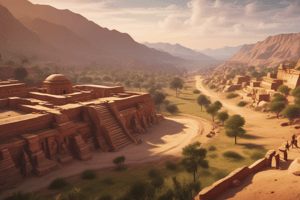Podcast
Questions and Answers
What factor led some archaeologists to suggest climate change as a possible reason for the decline of the Indus Valley Civilization?
What factor led some archaeologists to suggest climate change as a possible reason for the decline of the Indus Valley Civilization?
- Presence of advanced trade networks
- Existence of fortified cities
- Cities being abandoned over time
- Evidence of volcanic eruptions (correct)
What evidence suggests the Indus Valley Civilization had a well-planned economy?
What evidence suggests the Indus Valley Civilization had a well-planned economy?
- Trading only within the Indian subcontinent
- Lack of any commodities in excavations
- Presence of standardized weights and measures (correct)
- Abundance of gold artifacts in excavations
What is a unique characteristic of the Indus script that has hindered its decipherment?
What is a unique characteristic of the Indus script that has hindered its decipherment?
- Translation into multiple languages
- Simple alphabet
- Complex symbols (correct)
- Similar to Mesopotamian script
How did the emergence of Iron Age cultures mark the transition from the Middle Bronze Age after the collapse of the Indus Valley Civilization?
How did the emergence of Iron Age cultures mark the transition from the Middle Bronze Age after the collapse of the Indus Valley Civilization?
In what way did the legacy of the Indus Valley Civilization influence Indian society post-decline?
In what way did the legacy of the Indus Valley Civilization influence Indian society post-decline?
What aspect of the Indus Valley Civilization continues to inspire the contemporary world according to the text?
What aspect of the Indus Valley Civilization continues to inspire the contemporary world according to the text?
What is another name for the Indus Valley Civilization?
What is another name for the Indus Valley Civilization?
During which period did the Indus Valley Civilization reach its peak?
During which period did the Indus Valley Civilization reach its peak?
What evidence suggests that the Indus Valley Civilization evolved from the early Neolithic period?
What evidence suggests that the Indus Valley Civilization evolved from the early Neolithic period?
What was a key feature of the urban planning in the Indus Valley Civilization?
What was a key feature of the urban planning in the Indus Valley Civilization?
What aspect of the Indus Valley Civilization indicated a high level of public health awareness?
What aspect of the Indus Valley Civilization indicated a high level of public health awareness?
Which present-day countries encompass the area where the Indus Valley Civilization thrived?
Which present-day countries encompass the area where the Indus Valley Civilization thrived?
Flashcards are hidden until you start studying
Study Notes
Indus Valley Civilization
The Indus Valley Civilization refers to several ancient civilizations that thrived during the Bronze Age in the northwestern South Asian region between 3350 BCE, and its fall around 1900 BCE. This civilization is one of the world's most ancient urban civilizations, encompassing the areas of present-day India and Pakistan. The Indus Valley Civilization is also known as the Harappan civilization, named after the city of Harappa in present-day Pakistan, which was one of its major urban centers.
History and Evolution
The Indus Valley Civilization is believed to have evolved from the early Neolithic period, as evidenced by archaeological remains from Mehrgarh, a site in the Kachi Plain of Balochistan, Pakistan. The civilization reached its peak between 2600 BCE and 1900 BCE.
Cultural Practices and Society
The Indus Valley Civilization was characterized by its urban planning, advanced sanitation systems, and social stratification. The cities were laid out on a grid system, with streets running in a north-south and east-west direction, which suggests a well-planned urban planning. The cities were also well-connected by a system of roads and highways.
The civilization was known for its advanced sanitation systems, with well-planned drainage systems, indicating a high level of public health awareness. The Indus Valley Civilization also had a social structure with different classes, as evidenced by the presence of fortified cities, which were different from the other urban centers.
Economy and Trade
The Indus Valley Civilization had a thriving economy, as evidenced by the presence of commodities like copper, bronze, beads, and pottery in excavations. The civilization had a well-planned economy, with a system of weights and measures that indicates a standardized system of trade.
The civilization also had a sophisticated system of trade networks that stretched beyond the Indian subcontinent, extending as far as Mesopotamia and the Persian Gulf.
Writing Systems and Scriptures
The Indus Valley Civilization had a complex writing system that has yet to be deciphered, known as the Indus script. Although researchers have made progress in interpreting this script, it remains largely undeciphered due to its unique characteristics.
Decline and Aftermath
The decline of the Indus Valley Civilization was gradual, with the cities being abandoned over time. The reasons behind this decline remain under debate among archaeologists, with some suggesting climate change, invasion by foreign forces, or internal conflict as possible causes.
After the collapse of the Indus Valley Civilization, Indian society entered the Middle Bronze Age, characterized by the emergence of Iron Age cultures. However, the legacy of the Indus Valley Civilization continued to influence Indian society, as evidenced by continuity in urban planning, agriculture, and craft traditions.
Legacy
Today, the Indus Valley Civilization stands as a testament to ancient India's cultural heritage and scientific advancements. This civilization significantly influenced the formation of South Asian culture and society. Despite the passage of millennia, the contemporary world continues to draw inspiration from the architectural marvels, urban planning, and socioeconomic structures of the Indus Valley Civilization.
Studying That Suits You
Use AI to generate personalized quizzes and flashcards to suit your learning preferences.




